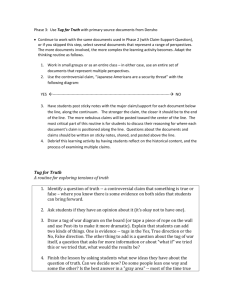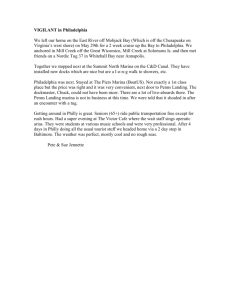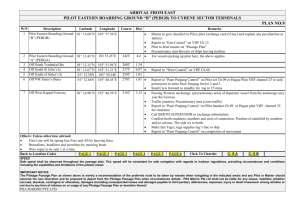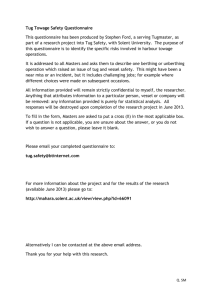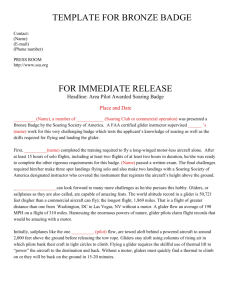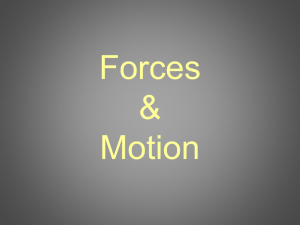lines of responsibilty - Waikerie Gliding Club
advertisement
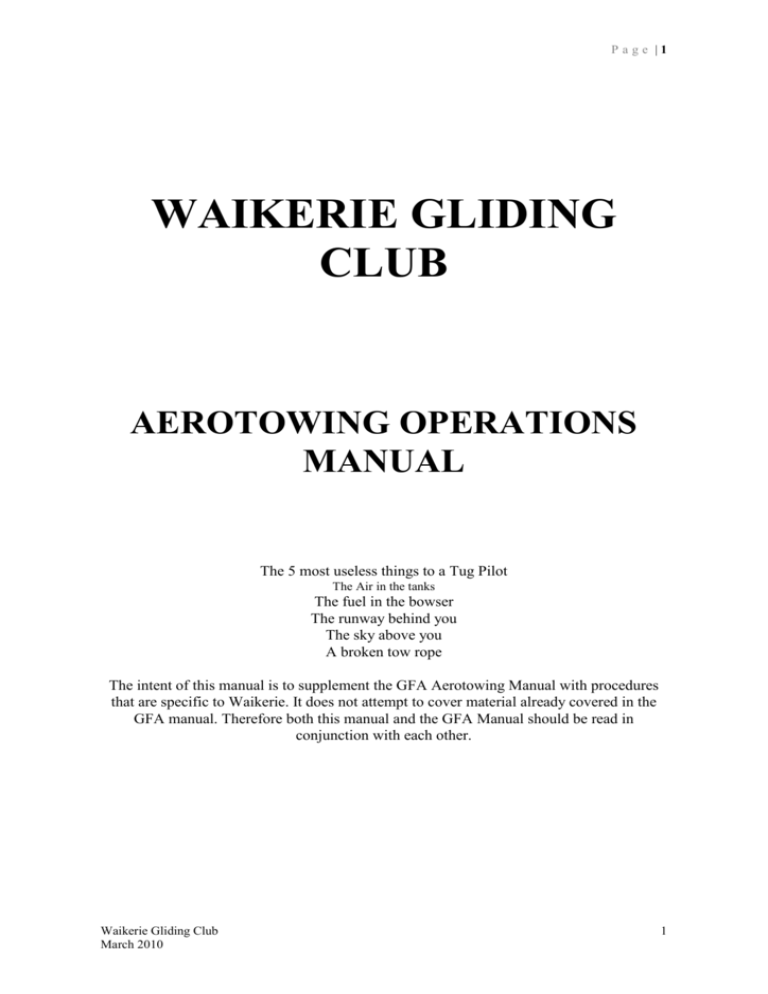
P age |1 WAIKERIE GLIDING CLUB AEROTOWING OPERATIONS MANUAL The 5 most useless things to a Tug Pilot The Air in the tanks The fuel in the bowser The runway behind you The sky above you A broken tow rope The intent of this manual is to supplement the GFA Aerotowing Manual with procedures that are specific to Waikerie. It does not attempt to cover material already covered in the GFA manual. Therefore both this manual and the GFA Manual should be read in conjunction with each other. Waikerie Gliding Club March 2010 1 P age |2 Contents Part 1 Responsibility 3 Part 2 Part 2.1 Part 2.2 Part 2.2A Part 2.2B Part 2.2C Part 2.2D Part 2.2E Part 2.2F Part 2.2G Part 2.2H Part 2.2I Part 2.3 Part 2.4 Part 2.5 Part 2.6 Part 2.7 Part 2.8 Part 2.9 Part 2.10 Part 2.11 Part 2.12 Part 2.13 Normal Operations Flight Notification Preparation Licence and Recency Daily Inspection Fuel Tow Rope Release Weak Link Mirrors Starting and Radio Warm up Towing Procedure Towing Pattern Release Descent Circuit Pattern Landing Taxiing Shut Down Rope Dropping Double Towing Operation and Engine Management 5 5 5 5 6 6 6 6 7 7 Part 3 Part 3.1 Part 3.2 Part 3.3 Emergency Procedures Ground Roll Below 500 FT Above 500 FT 12 13 13 13 Part 4 Operations at Waikerie Airfield 14 Part 5 Operations away from Waikerie Airfield 15 Part 6 Maintenance and Defects 16 Appendix A Appendix B Appendix C Appendix D Appendix E Appendix F Appendix G Preflight PA25-235 Outlanding Retrieve Refresher Course Outlanding Briefing Tug Pilot Documentation VH-WGC Operation and Engine Management 19 20 21 22 23 Waikerie Gliding Club March 2010 7 8 8 9 9 9 9 10 10 10 11 11 11 2 P age |3 PART 1 RESPONSIBILITY As a tug pilot with Waikerie Gliding Club, you are subject to the direction of the Club’s Flying Operations Panel (FOP), which consists of the Clubs regular gliding instructors, Coaches and Tug Pilots. The towing policies and procedures of the FOP are enforced through the Tug Master or his/her deputy, and the Chief Flying Instructor (CFI) or Duty Instructor of the day in matters of flying discipline and standards. Your attendance at the FOP meetings provide the opportunity to input to the procedures and flying operations of the Club. The high standards required are in accordance with this Operations Manual and the GFA Aerotowing Manual. These 2 manuals expand on the minimum requirements for operations and standards as are laid down by the Civil Aviation Safety Regulations and Orders. Tug pilots are immediately responsible to the Tug Master for the conduct of flying and standards. All tug pilots may be subject to checks of procedures and practices, as applies to all other flying members of the Club. The recency requirements and qualifications are described in Parts 2 and 3 of the GFA Aerotowing Manual. Copies of records of the required information are to be given to and held by the Tug Master (or his deputy) at the Gliding Club in accordance with Appendix C. It is the individual Tug Pilot’s responsibility to ensure that records are up to date. Some towing activities may be in relation to passenger carrying operations and as such it is a requirement under the CASR’s that the records of qualifications and validity be retained by the Club. Failure to do this will result in the withdrawl of the Towing permission at Waikerie. Under no circumstances should aerotowing activities be conducted unless all documentation is current (See Currency, Appendix C) A notice left in the aircraft or in the aircraft Maintenance Release will show urgent information about tug operation or serviceability. It is a Tug Pilot’s responsibility to notify the Duty Instructor of the day together with the Tug Master or his/her deputy of any accident, incident, or any other significant event which occurs while you are the Pilot in Command of a club tug aeroplane. In respect to incidents and accidents a written report to the CFI is required in addition to the normal reporting requirements of CASA. It is the Tug Pilot’s responsibility to satisfy themselves that all procedures are safe. Pilot’s must refuse to be a party to any operation where safety may be compromised. Always err on the side of safety. Aerotowing is a very low discipline environment and as such, Tug Pilots must exercise tight self-discipline to ensure all checks are completed every time, completely and thoroughly. Waikerie Gliding Club March 2010 3 P age |4 Intentionally blank Waikerie Gliding Club March 2010 4 P age |5 Part 2 NORMAL OPERATIONS 2.1 Flight Notification All VFR aircraft are exempt from flight notification and reporting for individual flights, provided that: 1. The aircraft remains outside controlled airspace (OCTA) 2. A listening watch is maintained on the VHF area frequency, or CTAF as appropriate. The airspace around Waikerie is a CTAF. It is necessary to travel a long distance before Controlled Airspace is encountered. During aerotow retrieves, it is a requirement that the Duty Instructor or Tug Master is aware of the retrieve and the outlanding location. This will allow a local SAR watch to be maintained. The requirements for paddock retrieves must also be considered. 2.2 Preparation 2.2A Check your Licence and Towing Permit validity and recency. While a Pilots License is permanently valid, the Medical Certificate is not. Pilot’s are not permitted to exercise the privileges of the license unless the Medical Certificate is valid. It is also a requirement to have undertaken a Biannual Flight Review within the preceding 2 years and have this recorded in your Log Book. The recency requirements as laid down in the GFA Ops manual are also required to be satisfied. In addition to the CASA and GFA recency requirements, tug pilots with outlanding retrieve approval are also subject WGC recency requirements. Outlanding retrieve approved pilots must have carried out at least one paddock retrieve within the preceding 2 years, completed a paddock retrieve refresher course as detailed in Appendix 2 within the preceding 2 years or be approved by the Tug Master if you have recent relevant experience in paddock operations (eg. Outlanding in a glider). This mandatory gliding club requirement is intended to keep pilots familiar and safe with the abnormal environment encountered during this type of operation. If a Tug Pilot’s License, Medical Certificate, Flight Review or towing recency is not current, a pilot is not permitted to fly the Tug under any circumstances. If the need arises to renew the tug rating or if recency is out of date, contact the Tug Master. Waikerie Gliding Club March 2010 5 P age |6 2.2B Daily Inspection, PA-25 Pawnee - see Appendix A Additional Daily Inspection Items 2.2C Check fuel contents and sample - It is a Club requirement to always land with a minimum of 45 minutes fixed reserve of fuel. This equates to approx 45 litres. There is no acceptable excuse for contravention of this requirement. There must be at least 45 litres fuel plus the tow fuel required for the aerotow, before takeoff. The tug should be completely filled at the end of the days flying and refilled during the day as required. Experience has shown that for the Pawnee, useful methods of keeping track of fuel burn include: - deducting 1 litre per 300 ft of climb. Eg. A 2000 ft launch would use 6.66 litres ( round it up to 7 litres). - deducting 1 litre for each minute of tow time. Do not however rely on one method of fuel management! If there is a fuel leak or the engine is using an abnormal amount of fuel, this must be known by the pilot. This can be achieved by using a combination of mathematical and visual methods - Maintain a fuel log (this is a mandatory requirement). - Regularly look at the fuel gauges. - Count the number of launches. - Dip the tanks. By cross-referencing all of the above a good “situational awareness of the remaining fuel can be maintained. Do not ever be forced into a launch if you are concerned about the fuel status. Always maintain a Fuel Log - I'ts a requirement of flying the Tug. There never has and never will be a suitable reason for fuel exhaustion. It is entirely your responsibility. 2.2D Check the condition of the Tow rope - Tow ropes are generally of manufactured fibres such as polypropylene, polyethylene, etc. Steel cables or wire must never be used. The Gliding Federation of Australia recommended rope length for aerotow is 55 metre, and at no time in normal circumstances will the ropes be less than 40 metres long. Special consideration may be given to shorter rope lengths than 55 metres for purposes such as paddock retrieves and double towing. A short rope is identified and available for paddock retrieves but make sure the glider pilot is experienced enough to cope with the short rope. If in doubt, use the normal rope. Learn how to repair a tow rope. 2.2E Check the release mechanism, make sure it operates at all angles. (AD/Supp/ 8 inspection) - Approved release installations will enable the pilot to release the tow rope while it is carrying a load up to the weak link specification, and since the sailplane may under some conditions reach extreme positions in relation to the tug, the release installation must be operable with Waikerie Gliding Club March 2010 6 P age |7 this load applied in any direction up to 20 degrees from the normal towing direction. Tug pilot’s must satisfy themselves they can easily reach the tow release lever and obtain full movement. A Release check is to be carried out prior to the first flight of the day. 2.2F Check the weak link rope - If the breaking strength of the rope is more than 750kg, a weak link with a breaking strength not greater than 750kg must be interposed between the rings and the rope at the tug end, or the weak link specified in the sailplanes or tug’s Flight Manual must be used. When a weak link is used it shall be placed at the tug end so that it NEVER drags on the ground. It must be as short as practical so as not to drag on the ground. No evident visible deterioration in its condition is acceptable. 2.2G Check rear vision mirrors - The tug is fitted with mirrors adjusted so that the tug pilot can see the sailplane at all times when the sailplane is in a normal relationship to the tug. It is recommended to have the left mirror up and the right mirror down. This allows you to see the launch person on the ground and the glider in flight. 2.2H Starting and Radio Operation. Starting Ensure the following before getting into the cockpit. - Fuel sufficient and fuel caps secure. - Cowls and Nose locker door secure - Chocks removed. - Paperwork and Headset aboard. Maintenance Release – Completed. Switch Fuel to the desired tank (left or right) Master Switch ON Set mixture control – Full Rich Electric Fuel Pump – ON Throttle – 3 Pumps. - Set 1000 RPM Control Column – held fully back (or wind trim fully NOSE UP). Magneto LEFT ON Starter Button – PRESS until engine fires. Magneto RIGHT - ON Oil Pressure – Rising. Radio Master - ON Check operation of radio – Make a “Radio Check Call” to confirm the radio equipment is serviceable. All club gliders are fitted with VHF radios. Short meaningful communications allows essential information to be provided (particularly in an emergency), and provide situational awareness to other pilot’s in the area. It is recommended that tugs make an all stations call on the CTAF frequency (126.7) just prior to takeoff and when joining the circuit. Alerted see and avoid is a very important part of gliding operations. Failure to follow this technique has been factors in mid air collisions. As an enhancement to this procedure it is recommended to also announce the general location of Waikerie Gliding Club March 2010 7 P age |8 the tow pattern - an example – All stations Waikerie, Whiskey Golf Charlie lining up runway 26 Waikerie with glider on tow, climbing north west after take-off. 2.2I Warm up - Shock cooling of the engine during descent may cause enormous damage - shock heating may be just as damaging. It is not the actual temperature of the engine that is of concern (within the normal limits), it is the rate at which temperatures change that causes the damage. Large temperature variations within the engine may cause damage such as cracked cylinders, stretched crankcase through bolts and stuck valves. A warm-up may also be required if some time has elapsed since the last tow. It is recommended that the warm-up be conducted over a hard surface – on the apron, taxiway or sealed runway. 2.3 Towing Procedure The standard ground signals are used at Waikerie as detailed in the GFA aerotowing manual. The radio may be used to eliminate any confusion during the launch signals. Give an “All Stations” runway line up radio call. After taking up slack in the rope and being given the “all out” signal ease the throttle forward to gain full R.P.M., maintain a straight take off path and wait for the aircraft to lift off (do not force the aircraft off the ground before it is ready to fly and establish a towing speed of 70 kts unless the sailplane pilot requests a different speed. 2.4 Towing Pattern Tugs towing sailplanes should comply with the normal rules of the air and circuit procedures where possible, climbing straight ahead after take-off to 500 feet before making a turn to the left. A modified pattern may be desirable depending on the suitability of the overshoot area for glider landing due to rope break or tug emergency, the position of the sun, wind etc. Some suggested tow patterns are illustrated below. It is desirable to keep the sailplane within gliding distance of the airfield or a suitable landing area and should not be towed downwind unless requested by the glider pilot. With inexperienced sailplane pilots, turns should be made gently and at reasonable bank angles. Remember to look for sources of lift (thermal, wave etc) whilst towing. Only attempt to circle in thermal lift if it is you know the capabilities of the sailplane pilot you are towing and if there are no other aircraft in near proximity. Remember to keep a good lookout for other gliders and aircraft. (Remember alerted see and avoid). Consider the takeoff point – which is usually made from the centre of the irrigated grass pads. This position however is at least 1/3 of the way down the Waikerie Gliding Club March 2010 8 P age |9 runway. Consider the weight of the glider being towed, the current temperature and wind, the available over run area and the landing options available if the tug should have an engine failure. There are virtually no suitable emergency landing areas off runways 26 and 02 in the event of an engine failure below 400 to 500 ft. If not comfortable with any of the conditions, push the glider back and start the takeoff run from the beginning of the runway. While the glider pilot/s may object and claim it is unnecessary, consider that an engine failure situation off 26 or 02 the glider will almost certainly be able to return to the field. Discuss it with the Duty Instructor and use the full length if you deem necessary. Remember to fly neighbourly - avoid flying over Waikerie Township and directly over houses. If the object of the glider flight is a scenic look flight over the township, tow to a point abeam the township and after a normal release, track away from the township. WGC has a good relationship with the local community (which we want to preserve) and noise complaints are taken seriously. 2.5 Release of Sailplane Establish positively that the sailplane has RELEASED the rope, LOOK OUT to the left, turn LEFT and gradually reduce POWER to 2300 RPM to avoid engine overspeed and commence DESCENT. Establish a descent SPEED of 103kts. Do not carry out any “aerobatic” maneuvers into the descent phase (ie angles of bank should not exceed 60 degree). 2.6 Descent Consider the effects of thermal shock on the engine whilst on descent. Maintain 2300 RPM during the descent with gentle power reductions during the latter stages of the descent. Maintain a good lookout for other gliders and aircraft, which can be difficult to see while descending. Plan to enter the circuit at around 700 to 1000 ft. 2.7 Circuit Pattern Observe other aerodrome traffic to establish adequate separation. Conform with the pattern established by other traffic. Complete the pre-landing checks and make the circuit joining radio call. Maintain a vigilant lookout and listening watch for other aircraft. Gliders are difficult to see when approached from the rear and generally the tug speed is 30-40 knots faster than gliders. The tug rate of descent is usually higher and it is possible to descend on top of a glider. SEE and AVOID has some physical limitations due to the inability of the eyes to focus at the correct distance and because the eyes usually only see things that are in relative movement. If a glider is approached from the rear it is normally stationary in your field of view and you probably won’t see it. ALERTED SEE and AVOID builds situational awareness and will assist in seeing the glider. Waikerie Gliding Club March 2010 9 P a g e | 10 A close in base leg is acceptable providing the approach of other aircraft are not compromised. REMEMBER that there may be aircraft flown by student pilots or pilots unfamiliar with gliding operations. A simulated rope break is carried out to train or check a pilot.If the glider has released in a simulated or real rope break, give the glider right of way. Depart from the circuit if necessary. Keep a careful look out for sailplanes or other aircraft conducting non-standard circuits. Look out for gliders on long final. 2.8 Landing Ensure the landing area is clear of obstructions, use normal approach speeds for “final” ( 60-65kts). Use Flap as required. Remember the tow rope trails below the flight path so ensure it clears obstructions (fences, vines , etc) on approach. Only use wheel brakes when necessary and then only when all three wheels are firmly on the ground. Do not turn in front of a tug and sailplane combination in the process of launching. Turn off to tow another sailplane or to park when reaching walking pace. Endeavour not to taxy over the tow rope. 2.9 Taxiing When taxiing near sailplanes, Pie-cart etc always be conscious of - the proximity of the moving propeller to people, particularly visitors to the field. Children and others often don’t look! - The propeller wash and glider canopies and dust. - Do not leave the tug’s engine running unnecessarily. - Of where the tow rope is. Do not drag it over other gliders or around people. Irrigation sprinklers are laid out across or stored near runway markers on both the inactive runway and on the active runway early in the morning and late afternoons. The sprinkler wires that pull the sprinklers along are a particular hazard and can easily be caught in the main or tail wheels. Taxiing or taking off over the wires is forbidden. Exercise extreme care when turning or taxying downwind. 2.10 Shut down Procedure Turn off the radio and allow the engine temperatures to stabilize before setting the mixture control to idle cut-off. Turn both Magneto’s and the Master switch OFF. Remove the rope off the runway. Waikerie Gliding Club March 2010 10 P a g e | 11 2.11 Rope Dropping It is normal practice for the tug to land with the tow rope attached. It is essential that the approach be made in such a manner that there is no possibility of the rope causing any damage to persons or property or becoming entangled in a fence or obstruction. 2.12 Double Towing Towing of two sailplanes by one tug aircraft may be carried out under the conditions laid down in the GFA aerotowing manual section 5.3. by appropriately rated Tug and glider pilots. 2.13 VH-WGC – Operation & Engine Management . ADDITIONAL NOTES Refer to APPENDIX E for additional notes in respect of the operation and care of the Club’s Tug aircraft. Waikerie Gliding Club March 2010 11 P a g e | 12 PART 3 EMERGENCY PROCEDURES All emergency procedures are in accordance with the GFA Aerotowing Manual with the following additional information. 3.1 Engine failure, Loss of Power, Control problems, etc during ground roll During the ground “take off” run if the tug suffers either complete loss, partial loss of power or the sailplane becomes dangerously out of station etc. - Release the tow rope (if the sailplane has not already done so). Reduce power (if still available) and stop gradually straight ahead. Note - In some circumstances when near flying speed has been attained and with full power available, providing the sailplane has been released, it may be prudent to continue with the “take off” and conduct a normal circuit and landing. If the sailplane gets out of station vertically prior to tug lift off and pulls your tail up the tug pilot should release the sailplane IMMEDIATELY he/she feels this condition is STARTING TO DEVELOP. There should be no delay – with full back pressure required on the control column to maintain attitude the tug will not lift off and if the sailplane does release at this point the tug will certainly cartwheel and finish on its back. This is an EXTREMELY DANGEROUS emergency and you MUST RELEASE the sailplane IMMEDIATELY you feel this situation starting to develop. 2 After Lift Off and Below 500 Feet A.G.L. If for any reason, continuation of a tow is hazardous, WAGGLE WINGS to signal sailplane to release. If sailplane does not release, the tug must do so IMMEDIATELY.. If the emergency is an engine malfunction, do NOT adjust power prior to release and if possible substitute speed for height (but maintain a safe speed) to enable a safe forced landing. If the malfunction is total engine failure, lower the nose to maintain safe air speed, waggle wings, release and land straight ahead or within 15 – 20 degrees either side of heading. The options during an engine failure at Waikerie are not great because of the gradual build up of houses and fences around the airfield. If faced with this situation, the best outcome will be achieved if control of the aircraft is maintained until after touch down. If servere or erratic maneuvers are attempted or airspeed is lost, it is likely loss of control of the aircraft will result. 3.3 On Tow Above 500 feet A.G.L. Tug to Sailplane - “Release now” - tug pilot waggles the wings vigorously. On seeing this signal the SAILPLANE pilot MUST RELEASE IMMEDIATELY whether in high or low tow and having seen the tow rope go, the sailplane should (except where circumstances do not permit) execute a clearing turn to Waikerie Gliding Club March 2010 12 P a g e | 13 the right. If the sailplane does not do so immediately, operate the tug release lever to release the sailplane from the tug. If the emergency is a total engine failure, carryout normal forced landing procedures. GENERAL: Seek the co-operation of gliding Instructors to practice these emergencies as often as possible, BUT, note the following carefully:-Any emergency which has not been prearranged between tug and sailplane pilots, IS REAL event. -Every practice must be clearly and specifically prearranged between sailplane and tug pilots. In any flight, if ONE emergency procedure is prearranged, the SECOND one is a REAL event. -During landing on Tow practice, prearrangement MUST identify clearly it is to be either:FULL STOP landing or, TOUCH AND GO. Take nothing for granted in practicing emergency procedures. Waikerie Gliding Club March 2010 13 P a g e | 14 PART 4 OPERATIONS AT WAIKERIE AIRFIELD Gliding operations may be conducted from the separate glider runways parallel to but outside the main runways. These glider runways meet the required ALA standards and are marked by orange gable markers. Although gliders occasionally land outside these areas for various reasons, glider launching may also take place outside the designated glider runways. Normally, circuits to both the normal power runways and the glider runways are standard left-hand circuits. Contra circuits are not operated at Waikerie. Minimum separation standards exist as per OPS 46.2. The parallel power and glider runways are to be treated as a single runway for separation minima. IE. the tug should not land or takeoff in parallel with another aircraft on the bitumen strip. Beware of sprinklers and their associated wires which may be laid out across the glider runways particularly in the morning or afternoon. The tug and glider shall use the CTAF frequency (126.7) during the entire launch and within 10km of the airfield. Taxiing broadcasts prior to takeoff are required (OPS 47.2). A listening watch can be maintained on two frequencies in the Clubs Pawnee. It is requirement to give a circuit joining call. Remember the tow rope is trailing below the tug on approach. Be particularly careful on approach to runway 20, the grapevines are surprisingly close to the threshold. Waikerie Gliding Club March 2010 14 P a g e | 15 PART 5 OPERATIONS AWAY FROM WAIKERIE AIRFIELD (Including Paddock Retrieves) All operations away from Waikerie airfield must be authorised by either the The Duty Instructor or Tug Master. A Tug Pilot may only undertake a paddock retrieve if holding the appropriate rating. A briefing about the glider pilots level of skill, history and details about the paddock are required before undertaking any paddock retrieve. The tug pilot is in charge of and has sole responsibility for the safety of the operation whilst away from Waikerie airfield. It must be noted that glider retrieves are not permitted from paddocks if the prevailing wind strength is in excess of the demonstrated crosswind component for the aircraft, in this case (for the Pawnee) 15 Kts. The landing and launch area must meet the requirements of an ALA. The pilot in command is responsible for determining if the paddock or area meets the requirements and authorising the use of that area. Remember, if it is necessary to consult the aircraft “P” Charts, the area is too small. Tow pilots must have the ability to refuse to tow if there is any doubt about the landing / take-off area. Radio communication is usually carried out on either the CTAF frequency or a gliding frequency. If you use the gliding frequency during the takeoff be sure to change to area and then CTAF frequency as required. See the Paddock Retrieve Briefing Sheet at Appendix D It is mandatory to carry the following equipment during a retrieve. - Emergency Locator Transmitter Water Glider tail dolly. A spare rope ( Short rope is available in the hanger and identified as such) Map.. Waikerie Gliding Club March 2010 15 P a g e | 16 PART 6 MAINTENANCE and DEFECTS Apart from items normally inspected as part of the Daily Inspection (eg Oil level, Tyre pressures, brake linings, etc) all maintenance is carried out at scheduled intervals and normally does not require pilot input. The aircraft is fitted with an hour meter and this should be used for recording the flight hours on the Maintenance Release ( not Tacho time). Ensure that the Maintenance Release is valid and current for the flight and that any recorded defects have been assessed and that no items of planned maintenance fall due during the intended flight/s. Most pilots are reluctant to write in the Maintenance Release. Pilots should understand their obligations are and how to write up entries in the Maintenance Release. At the completion of each flight the pilot in command is required to enter any known defects or damage on part 2 of the maintenance release (CAR248). Defects are catagorised as either Minor or Major Defects or Damage. CAR 2(1) defines a Major Defect or Damage as "a defect or damage of such a kind that it may affect the safety of the aircraft or cause the aircraft to become a danger to persons or property". No formal definition of minor defects or damage is given but it is assumed that any defects or damage not classed as Major may be classed as Minor Defects and Damage. The Pilot in Command, the Chief Pilot and the Registered Operator have the authority (CAR 50) to decide whether a defect or damage will be classed as Major or Minor. The definition of major defects and damage given by CASA is very broad and therefore further advice from the Tug Master, a maintenance organisation or a LAME may be prudent. Some specific items are automatically classed as Major and are listed below, while other items still require considered opinion. The following is a guide to assist in the evaluation. Items of equipment that are required for flight under CAO 20.18 "Aircraft Equipment-Basic operational requirements" are considered mandatory. Therefore if an item required by this CAO is unserviceable, it is considered a Major Defect. This CAO lists the minimum equipment required for a day VFR flight in Appendix 1 of the CAO, which in summary requires An airspeed indicator An Altimeter A Compass A time piece And a Turn Co-ordinator There are additional requirements for night VFR but normally will not apply to towing. Pilots should have a detailed knowledge of CAO 20.18. Waikerie Gliding Club March 2010 16 P a g e | 17 Mandatory instruments that are listed in Section 5 of the aircraft Flight Manual are in a similar position to those required under CAO 20.18. Therefore if an item listed as mandatory in the Flight Manual is unserviceable, it is considered a Major defect. Abnormal flight or ground loads are also classed as major damage. An abnormal load is one is which the pilot considers the aircraft was subjected higher "G" loads than the aircraft is certified for. This is almost certainly the case if severe turbulence has been encountered. Abnormal ground loads are not just related to heavy landings. High speed turns or ground loops may certainly result abnormal loads. Even very strong winds against a parked and tied down aircraft could result in damage to controls or landing gear. Other defects or damage that could be classed as Major include defects or damage that could cause A primary structure failure (including passenger seats) A control system failure An engine failure A fire After it has been determined what category of defect exists (Minor/Major), follow the following steps. Minor Defects or DamageIf the Pilot in Command determines that a particular defect is classed as Minor, the following procedure applies. Enter the defect in part 2 of the Maintenance Release. It is important to make the statement "Not Major Defect" or "Not Major Damage" as part of the entry. Continue the days operation unless it is considered operationally better to discontinue or alter the intended operation. Report the defect to the Tug Master. Major defects or DamageIf the Pilot in Command determines that a particular defect is classed as Major, the following procedure applies. Enter the defect in part 2 of the Maintenance Release. It is important to make the statement "Aircraft is Unairworthy" as part of the entry. Immediately report the defect or damage to the Tug Master who will arrange repairs to the aircraft. Also place a large note in the cockpit of the aircraft so that it is plainly visible to any pilot who may be preparing the aircraft for flight. DO NOT continue the planned flight or intended operation. To maintain the tugs as valuable assets pilots are encouraged to wash and clean the tug if there is spare time (ie between launches). This simple and regular activity will extend the life of the fabric and provides an indication of care and attention to visitors. Waikerie Gliding Club March 2010 17 P a g e | 18 There is a small stock of basic spares such as tyres and oil located in the main hanger. If able to competently replace these items, please do so to maintain the operation of the day. However do nothing if not comfortable carrying out the required repair. Waikerie Gliding Club March 2010 18 P a g e | 19 APPENDIX A PREFLIGHT INSPECTION PA25-235 This is a suggested preflight inspection based on the PA25 Owners Handbook. This list is an expansion on the Owners Manual with some additional items that should be checked. It may not be a complete list of all items worthy of inspection and additional items you feel are important may certainly be included at your discretion. Check the cockpit area and instruments for general condition and operation. Check seat belt attachments and operation of inertia reel. Check operation of all controls - flight, engine and electrical. Remember to turn the Master and Magneto switches OFF after inspection. Extend the flaps in preparation for the outside check. Check the condition and cleanliness of the windscreen and windows. Check operation of access door latches and hinges. Inspect the L/H wing and struts, top and bottom. Check aileron and flap attachments. Check condition of fabric for tears, holes or detaching strips, particularly under the wing where most of the damage is done. Check that all access covers under the wing are in place. Carry out a fuel check for water. Check the fuel level visually. Check the L/H Gear, including the attachment bolts and the brakes. The bolts virtually never fail but the attachment fittings that the bolts go through may crack. The brakes wear rapidly and must be checked every day! Some pads have a wear indicator slot in the edge of the pad - when the slot has disappeared, the pad is worn and requires replacing. . Open the engine cowls and inspect inside - oil or fuel leaks, broken wires, broken ignition leads, missing bolts, etc. Check the oil level. The engine normally holds 9 Lts on the dipstick. Add oil if the level gets below 8 lts. Check the prop for stone damage - cracks around the spinner attachment screws. Check the air inlet filter. After a paddock retrieve this may be full of grass. Check that all the cowl screws along the top front and back are in place they may vibrate out. Carry out the fuel drain.. Check the fuel level. Secure the fuel tank caps. Inspect the R/H gear as described previously. Inspect the R/H wing as described previously. Check the fuel level. Inspect fuselage side and bottom. The underside is difficult to look at but that is where there will be damage if any. Check fabric similar to wings. Check tail surfaces. Check fabric particularly underneath. This area regularly gets holes and tears from stones. Check bracing wires for tension and attachment. Check the Tail Wheel. Check the spring leaves for cracks and separation. Grease the tail wheel IF REQUIRED. Check the Tost release. Inspect the L/H side and bottom of the fuselage. Check the Maintenance Release for previous defects entered. Sign the Daily Inspection, recording any Oil added. Waikerie Gliding Club March 2010 19 P a g e | 20 APPENDIX B OUTLANDING RETRIEVE REFRESHER COURSE This course is intended to review the procedures and considerations of carrying out an outlanding retrieve and then to fly a simulated outlanding to put into practise what has been revised. This refresher is to be carried out with an Approved Check and Training Person. An outlanding retrieve approved pilot is required to undertake this refresher if that pilot has not carried out a paddock retrieve during the preceding 2 yrs, or has not been given approval by the Tug Master to carry out paddock retrieves. An outlanding approved tug pilot can apply to the Tug Master to waive the requirements of this course if he can demonstrate that he has relevant, similar experience. An example of this may be outlandings in a glider during cross country flights, agricultural pilots who regularly land in off airfield locations, etc. The intent of this club-enforced requirement is to maintain pilots familiar and safe for these operations. Theory Section 7 of the GFA Aerotowing Manual (page 38) provides a syllabus for the topics to be covered during this refresher. Additionally a review of Part 5 of the WISC operations manual should be covered, in particular the list of equipment required to be carried and the briefings to be undertaken. Flight Review The scope of the flight review is to be decided by the Approved Check and Training Person but must include demonstration of the following: Preparation of the tug for the simulated outlanding retrieve. The safe inspection of the intended landing area by fly past at progressively lower altitudes. The last flyby should be at a maximum of 50 ft AGL. It is NOT a requirement to actually land in the paddock. In fact it is discouraged because it puts the tug and pilots at unnecessary risk. An alternative to the paddock landing it is suggested to land on the Waikerie airfield near the windsock area. This area has a slight hill and will simulate landing on an undulating surface. Waikerie Gliding Club March 2010 20 P a g e | 21 APPENDIX C OUTLANDING RETRIEVE BRIEFING CHECKLIST Day:…………………………………………………………… Date: …../…../…… Tug Pilot: …………………………… Glider Pilot:………………………………… Glider: ……………………….VH-……….. Tug: VH-……………… T/O Area: Length …………..Metres, Slope: Level – Up-slope – Downslope Direction ...............Deg (M) Surface Hard - Firm - Soft Long Dry grass Long wet grass Short dry grass Conditions: Short wet grass Wind ………../………… (Note max 15 Kts wind) Temperature:………….C (Density Altitude) Density Altitude: ……………..Ft Obstructions On the ground In the area (circle) Fences Stones Stock SWER Lines Power Lines Dust Towers Erosion Gullies Other: …………………………………………………………………………………. Radio Frequencies T/O ………… Cruise ………….. CTAF (10 Km) 126.7 122.5, 122.7, 122.9, 124.3, 126.7 T/O Signals: Radio Airbrake - Open = Take up slack Climb Speed: ……….Kts Cruise: ……….Kts Retrieve Times: (Hour Meter) Tug T/O Time: YWKI: …………Hrs Tug T/O Time: ….........................Hrs Close = all out Altitude: …………Ft Land: ………… Hrs Land: ………….Hrs ………..Mins ………..Mins NOTES: ……………………………………………………………………………… …..................................................................................................................................... …………………………………………………………………………………………. …………………………………………………………………………………………. …………………………………………………………………………………………. Retrieve Approved – Briefing Completed – De-Briefing Waikerie Gliding Club March 2010 21 P a g e | 22 APPENDIX D TUG PILOT DOCUMENTATION REQUIRED BY WGC. The following information is required to be presented to the Tug Master to allow Club records to be updated / maintained; Copies of: a) Pilot License, showing Class and ARN. b) Aviation Medical Certificate, showing any restrictions. c) Logbook page showing Bi-annual Flight Review. Tug Pilot’s ARE NOT PERMITTED to operate the Club’s Tug aircraft ; a) unless these three documents are current / valid b) Currency requirements are met.. The Tug Master or CFI may also request to view the Tug Pilot’s Logbook to review recency, aerotowing experience, etc. Currency Requirements In order to be considered “in current flying practice”, tug pilot’s must a) Hold a valid Medical Certificate. b) Have completed a “Bi-annual Flight Review” within the preceding 2 years. c) Be able to demonstrate 3 normal take-off’s and landings in the preceding 90 days (3 months). d) Have completed 10 normal aerotows within the preceding 6 months to retain the Aerotow Rating. e) Have completed at least 1 paddock retrieve within the preceding 2 years to retain the “Outlanding Retrieve” Rating. Waikerie Gliding Club March 2010 22 P a g e | 23 APPENDIX E VH-WGC – OPERATION & ENGINE MANAGEMENT ADDITIONAL NOTES Tug Operation These additional notes for Tug Pilots have the objective of enhancing the operation, care and appearance of the Club’s Tug aircraft at the same time defining the Tug Pilots responsibilities. All Tug Pilots are requested to conduct their towing operations with these Notes in mind. 1. The Tug Pilot is responsible for the Tug from when it comes out of the hangar continuously until it has been returned to the hangar. 2. It is a requirement to maintain a written FUEL LOG. Fuel Logsheets are stored in the northern drawer of the Briefing Room desk. 3. A 45 minute FIXED RESERVE of fuel is required at all times. Flight fuel required is therefore 45 minutes plus the fuel required for the flight. 4. It is a requirement to complete the Maintenance Release each day, recording the following – Daily Inspection, any Oil Uplift, Inspection of the Tost Release, Hours and landings flown. All Oil Usage will be noted on the Oil Usage Logsheet, located near the spare oil in the Office. 5. A spare Tow Rope will be always be carried in the Nose Locker 6. Engine Operation. - Engine run-ups to are to be performed over a hard surface – on the apron, sealed taxiway or sealed runway to minimise soil erosion. - All engine power changes are to be undertaken smoothly. - Climb speed to be 70 Kts unless the glider pilot requests differently. - Descent is to be conducted at 2300 RPM (don’t allow engine to overspeed) to 500 Ft to prevent shock cooling. 7. The aircraft will be parked with the Radio Master OFF, both Magneto’s selected to OFF and the Master Switch OFF. 8. At the end of each days flying - The aircraft will be refueled and the fuel selected to OFF. - The Radio Master, Magneto’s and Master Switch will be selected to OFF - The Solar Charger is to be connected to the Tug battery. - The Maintenance Release will be completed. - The aircraft will be chocked at both main wheels. - The aircraft will be cleaned of all bugs, dust, oil etc. - Club headsets, knee-boards etc will be returned to the Tug Equipment drawer in the Office. Waikerie Gliding Club March 2010 23 P a g e | 24 9. All incidents (incidents, accidents, near hits, Human Factor event will be reported in writing to the Flying Operations Panel. Incidents include any rope break or failure (actual, caught on obstruction etc), aborted launch, events involving unplanned glider wave-off etc. 10.Any / all items of “Pilot Maintenance” are to be noted and attached to the Daily Flight Sheets. 11.Tug pilot’s are encouraged to a) develop and display high levels of Airmanship , and b) consider “Human Factors” in all aspects of towing operations, at all times while operating the Club’s Tug. Waikerie Gliding Club March 2010 24
